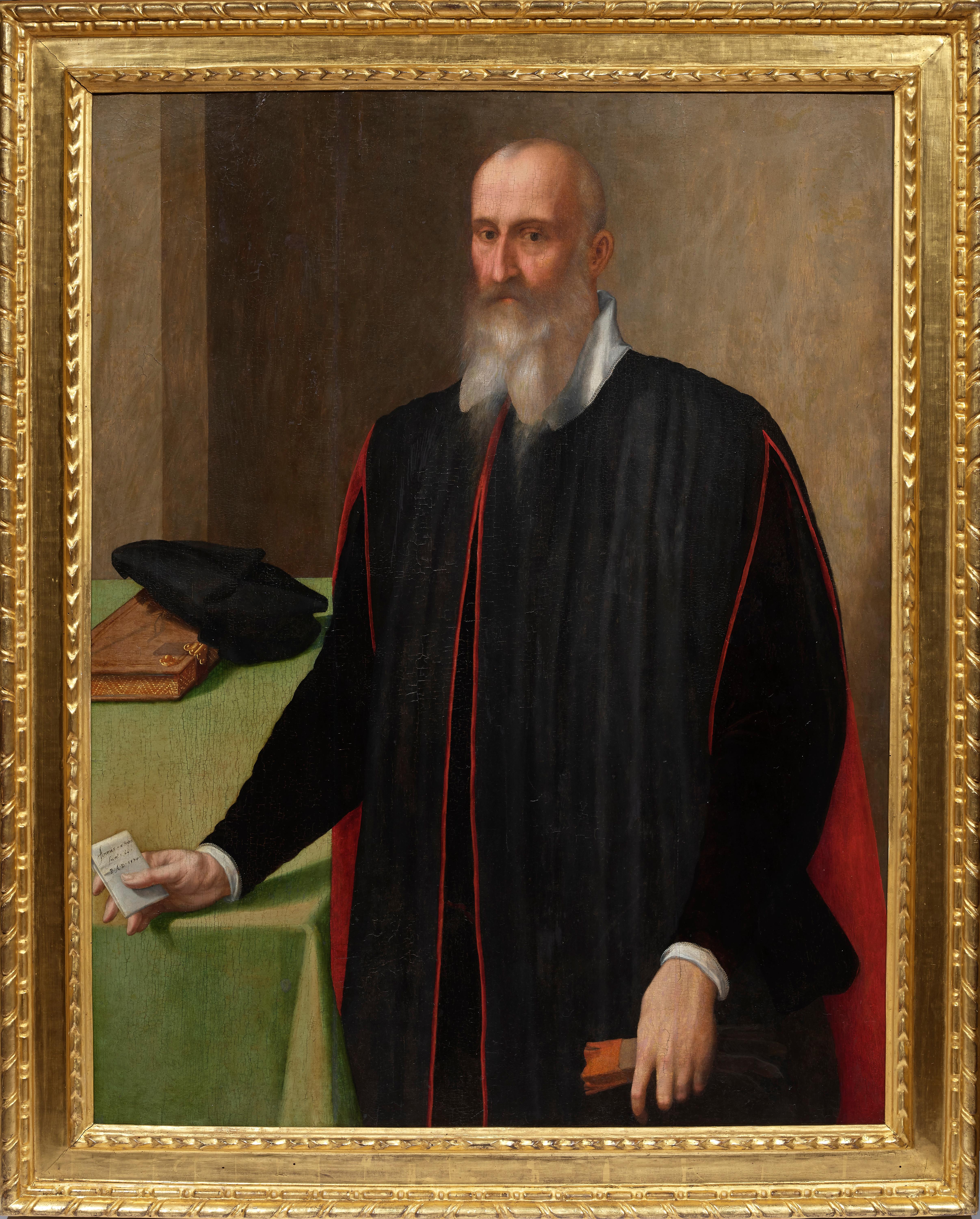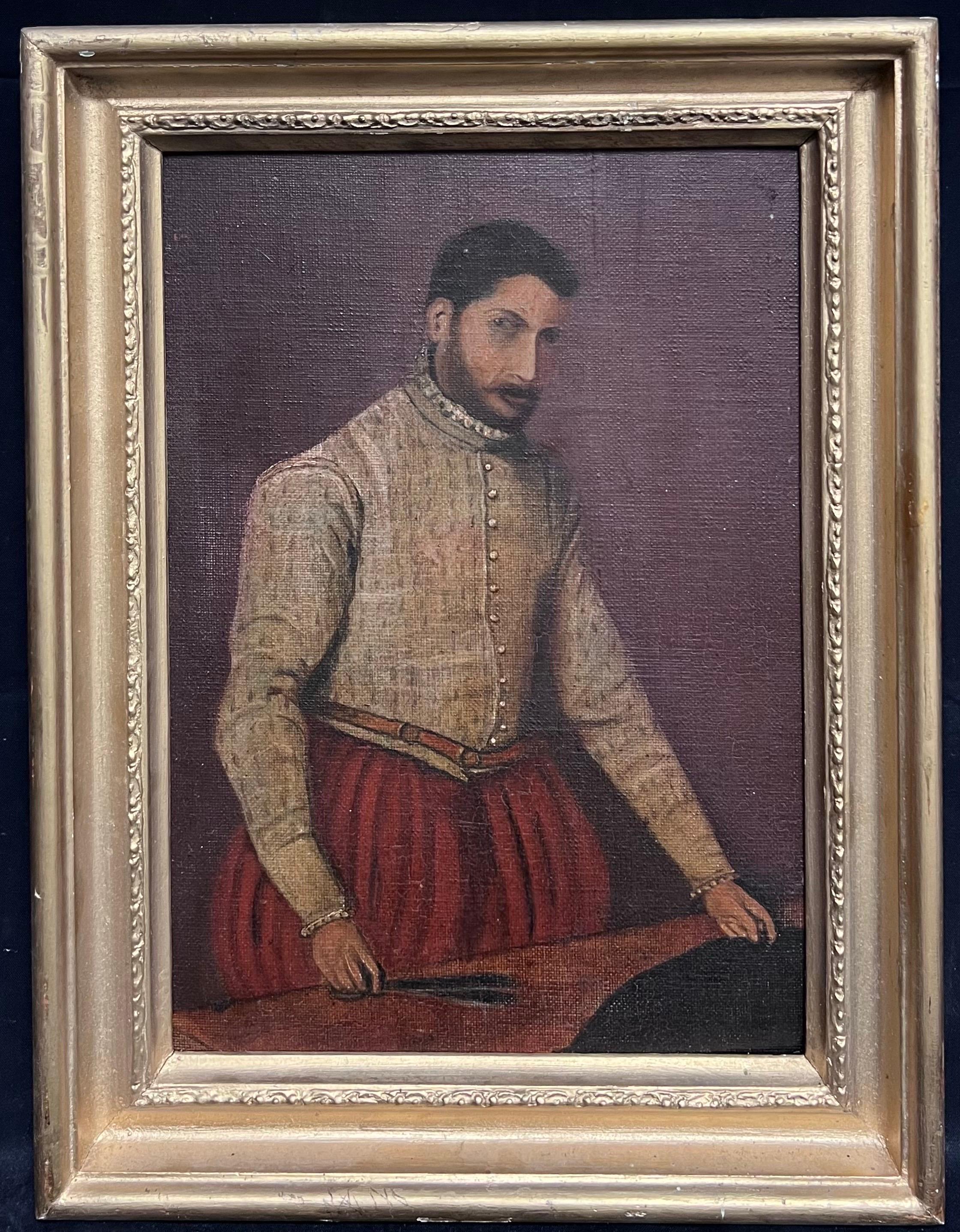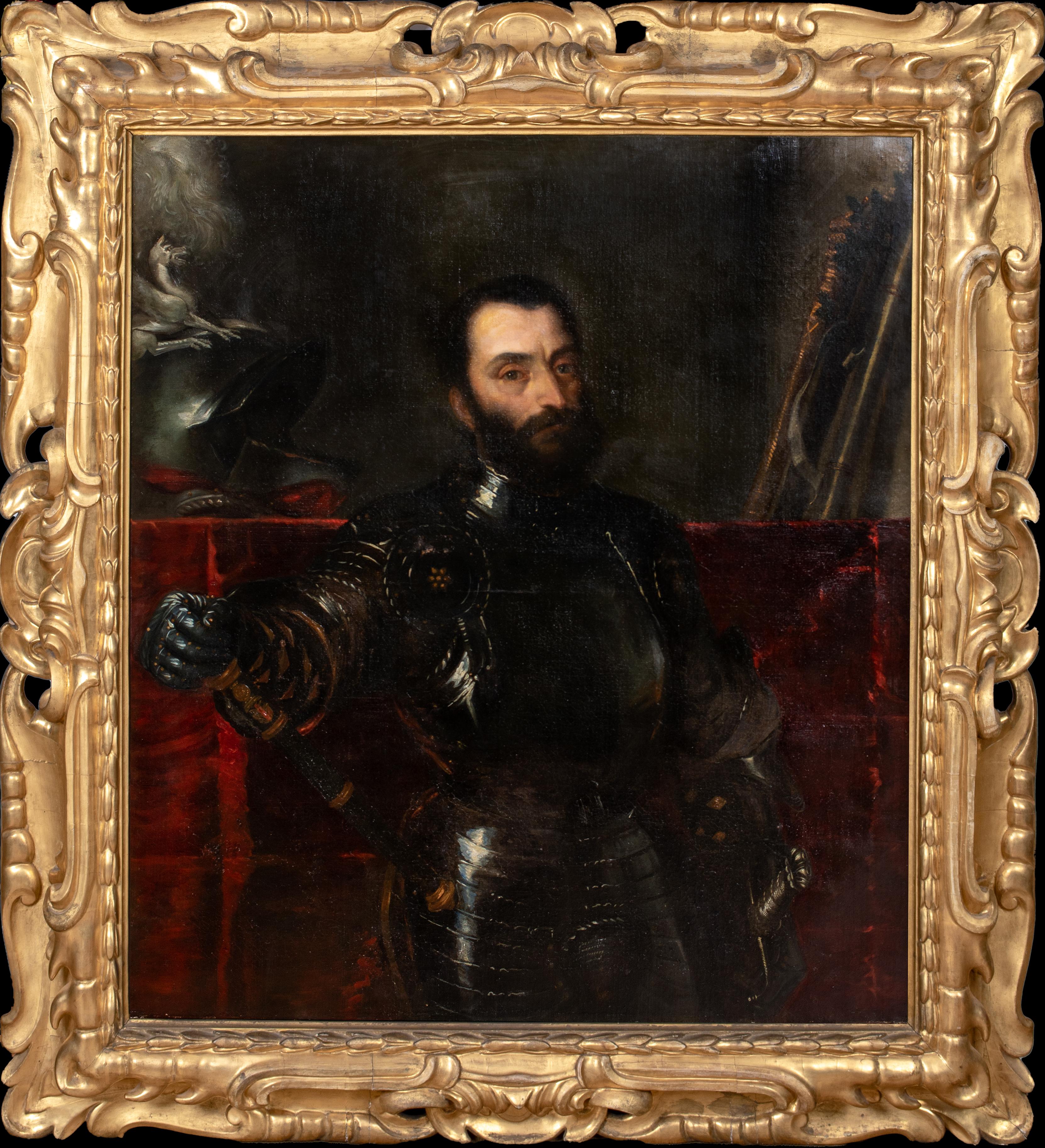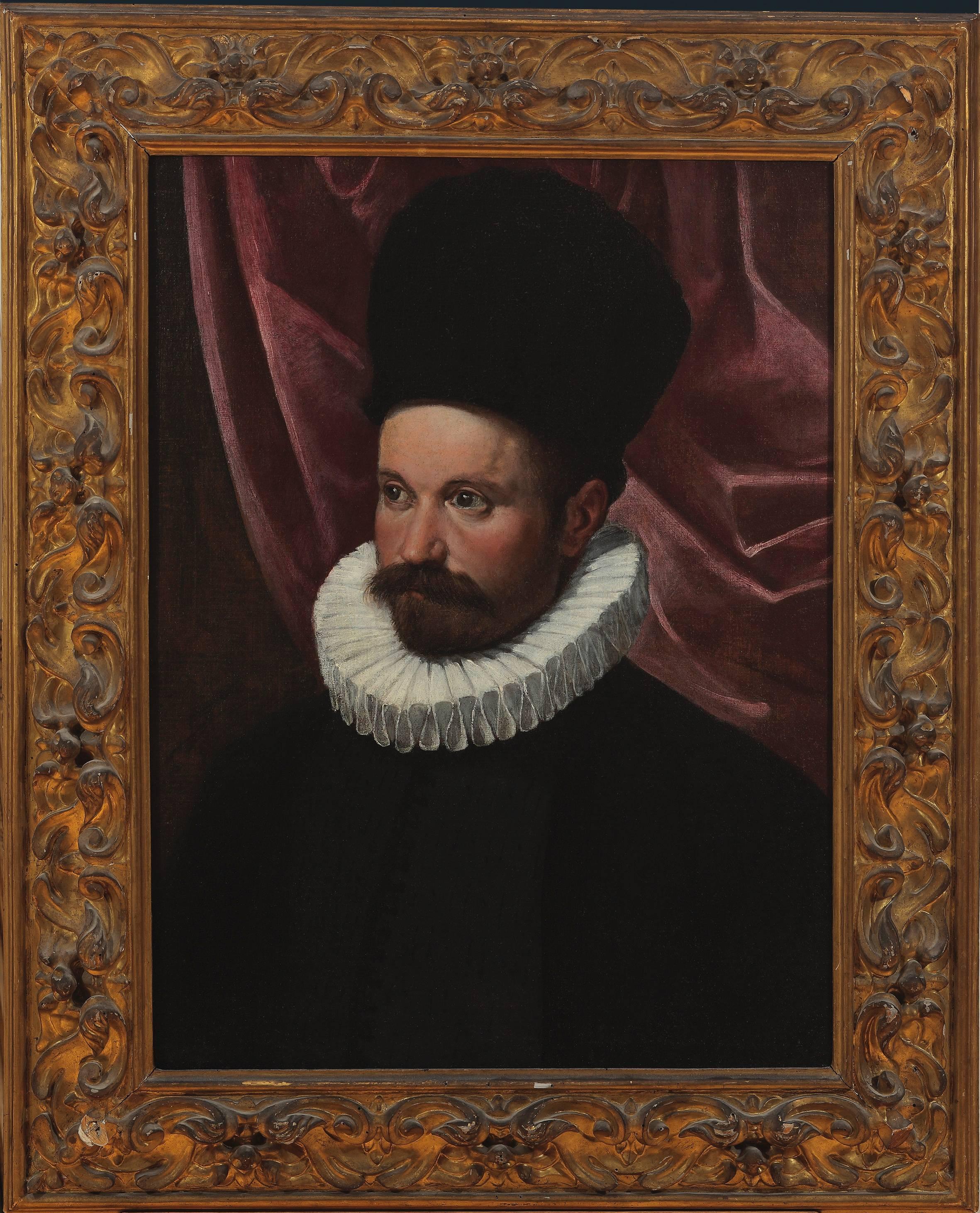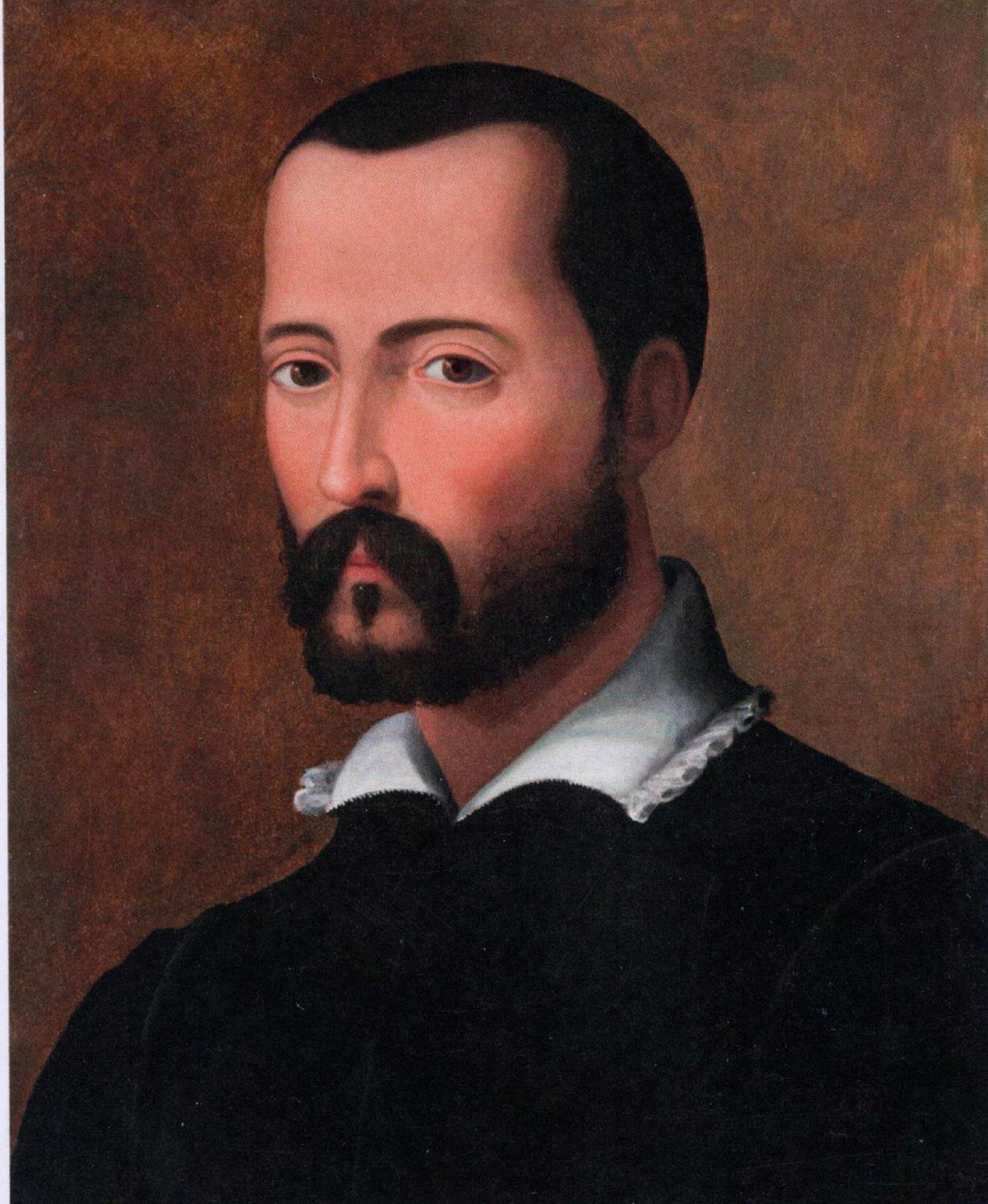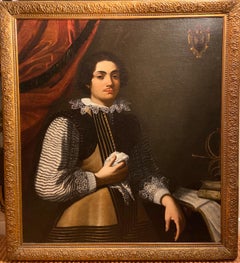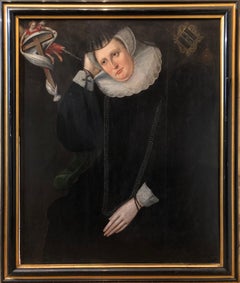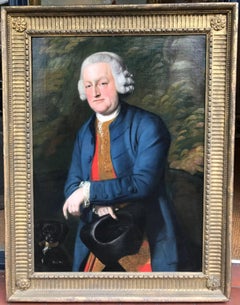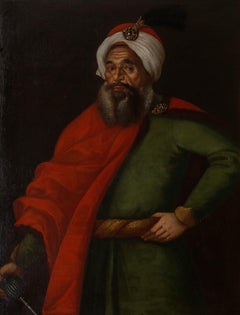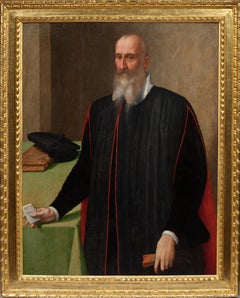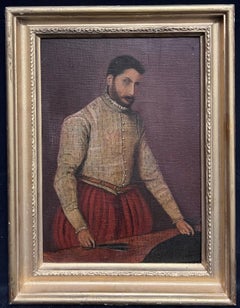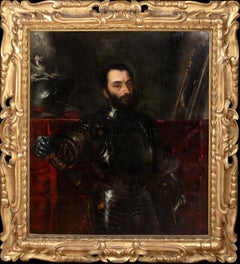Items Similar to 16th Century Italian Renaissance Old Master Portrait of a Procuratore
Want more images or videos?
Request additional images or videos from the seller
1 of 11
Jacopo Bassano16th Century Italian Renaissance Old Master Portrait of a Procuratorecirca 1550
circa 1550
$301,492.55
£220,000
€256,665.73
CA$412,969.42
A$459,312.14
CHF 239,838.53
MX$5,589,340.23
NOK 3,063,104
SEK 2,872,651.16
DKK 1,915,594.72
Shipping
Retrieving quote...The 1stDibs Promise:
Authenticity Guarantee,
Money-Back Guarantee,
24-Hour Cancellation
About the Item
Jacopo BASSANO (c. 1510-1592, Italian)
Portrait of a Procuratore
Oil on canvas
30 ¼ x 26 inches (including frame)
Provenance: Lucien Bonaparte’s Collection (as Portrait of Doge Priuli, Tiziano); Rich-mond, Virginia Museum, Portrait of Doge Lorenzo Priuli.
The painting is a portrait of a man half-length, on a black background. It is a three-quarter portrait, according to a custom very common in the genre of portraiture in sixteenth century. The man is wearing a decorated dark red velvet jacket, lined with ermine on the front. There can also be seen a dark stole draped over the sitter’s right shoulder and a black cap. The face is fully illuminated, and framed by a long, bushy grey beard. The beard is darker on the cheeks and almost white on the front. The sitter’s crimson jacket is in velvet, decorated with large floral motifs - concentric corollas of flowers – and it is edged with ermine.
In the catalogue of the collection of paintings of Prince of Canino Lucien Bonaparte (1775-1840), we can read that the painting was known as “Portrait of Doge Priuli” and attributed to Titian. The attribution to Titian, however, is no longer sustainable. Already in 1972, Federico Zeri, in his census of Italian paintings from America collections, and reporting the painting in the collection of the Museum of Richmond, Virginia, he did not confirm the name of Vecellio, preferring the term “Venice school, 16th century”.
The portrait has recently been confirmed as the work of Jacopo Bassano, by the Bassano academic Dr. Bernard Aikema, and is a significant addition to the corpus of that artist. The masterful handling of paint and the absolute naturalism are signatures of the work of Jacopo. The skill of the naturalistic rendering of the face (thin shadows in the area of the eyes, the light on one temple and the blue vein that is visible under the left eye) can be attributed to Bassano’s paintings of the late period. There are also features that you can find in his other portraits. The half-length in three-quarter pose is one that identifies almost all Bassano’s portraits, just as the dark background and the lack of contextual details (no objects, even the hands are excluded) that isolate the face and bring it to the fore.
The role of Jacopo Bassano as a portraitist has been the subject of considerable academic discussion. Just one signed portrait exists, and the attribution of the other portraits included in the artist’s catalogue raisonne is based exclusively on stylistic evidence. The account book that records all commissions for Jacopo and his father up to the 1550s, registers little more than a dozen portraits over two decades. The number of those works was increased gradually by critics, basing their attributions on the analysis of touch, colours and on the identification of his basic naturalism. In more than one of these portraits, for example in the Portrait of a Man at the Getty Museum in California, all the attention is concentrated on the face, without the insertion of the arms and hands and environmental details, and with the help of contrasting dark clothes.
The approach of these portraits is internalised, staking everything on the sitter and the expressiveness of his presence. A methodology that derives directly from Lorenzo Lotto and, more obviously, from Titian. A deep interpretation of a single personality and subject, supported by superb observation skills and the rendering of naturalistic reality.
A formal analysis of the painting allows us to date the work to the fifth decade of the sixteenth century. This was a period during which the work of Jacopo Bassano is faithful to a certain realism, and doesn’t yet display the gradual disintegration of form of the following decades. In comparison, it is appropriate to look at parts of other contemporary works by the artist, such as the hyper-realism in the rendering of the faces (especially San Giuseppe) in the different versions of the Flight into Egypt (the one in the Civic Museum at Bassano del Grappa, and that in Toledo. The comparison with the Adoration of the Magi in the National Gallery in Edinburgh is also interesting, with the male faces in the foreground, the old man and the kneeling person behind. Also, the heads of the old men in the Last Supper of the Galleria Borghese in Rome and in the Miraculous Draught of Fishes, now in Washington.
More striking is the comparison with the portraits. In addition to that of the podesta Bernardo Morosini, in the Staatliche Museen of Kassel, recognized by Rearick in 1980 (the portrait of the mayor, who held the city of Bassano from 1541 to '42, is documented in Libro secondo) One might sensibly suggest the Portrait of Cardinal, now in Szépművészeti Múzeum in Budapest (also present in Bonaparte collection): the same black background, the same refined attention to details in the face, the same half-length, and the same lack of descriptive elements.
The painting is initially registered as Portrait of Doge Priuli (and assigned to Titian); Federico Zeri finds it cataloged with the same words in the inventory of the Museum of Richmond, even with the clarification that this is the Doge Lorenzo Priuli. In the Sixteenth Century there are two Doges from the Priuli family, the brothers Lorenzo (1489-1559), elected doge in 1556, and Girolamo (1486-1567), elected after him.
What prevents us from identifying this painting as a portrait of a Doge is the dress worn by the subject, the crimson red decorated velvet jacket. This type of garment, with the stole, also velvet but darker in colour, and the cap, allows us to make some considerations that may affect the social status of this man. The colour of this velvet, decorated with giant caper flowers, was the exclusive prerogative of members of certain social categories and specifically of precise political offices. This dress, therefore, including the scarf on the shoulder, also velvet decorated with plant motifs, and the hat, appears to be the traditional "vesta" or "toga" worn by procurators and senators.
There are a number of portraits of procurators and senators portrayed by Tintoretto, which are wearing this type of garment, and in the catalogue of Jacopo Bassano, there are two portraits of senators of the same type: one now in Berlin, Portrait of senator, Staatliche Museen, Gemäldegalerie, and the Portrait Bernardo Morosini. The Doge, in his official portrait, was always represented with the robe, which identified him as such, which was different from that worn by our sitter, and above all wearing distinctive headgear, the “corno ducale”. This cannot, therefore, be a portrait of Doge. It is instead certainly a portrait of a senator, or procurator, and is likely to date from the mid-1540s.
- Creator:Jacopo Bassano (1510 - 1592, Italian)
- Creation Year:circa 1550
- Dimensions:Height: 30.25 in (76.84 cm)Width: 26 in (66.04 cm)
- More Editions & Sizes:UniquePrice: $301,493
- Medium:
- Movement & Style:
- Period:
- Condition:
- Gallery Location:London, GB
- Reference Number:1stDibs: LU67337878842
About the Seller
5.0
Vetted Professional Seller
Every seller passes strict standards for authenticity and reliability
Established in 1990
1stDibs seller since 2017
42 sales on 1stDibs
- ShippingRetrieving quote...Shipping from: London, United Kingdom
- Return Policy
Authenticity Guarantee
In the unlikely event there’s an issue with an item’s authenticity, contact us within 1 year for a full refund. DetailsMoney-Back Guarantee
If your item is not as described, is damaged in transit, or does not arrive, contact us within 7 days for a full refund. Details24-Hour Cancellation
You have a 24-hour grace period in which to reconsider your purchase, with no questions asked.Vetted Professional Sellers
Our world-class sellers must adhere to strict standards for service and quality, maintaining the integrity of our listings.Price-Match Guarantee
If you find that a seller listed the same item for a lower price elsewhere, we’ll match it.Trusted Global Delivery
Our best-in-class carrier network provides specialized shipping options worldwide, including custom delivery.More From This Seller
View All17th Century Italian Oil Painting Portrait of Music Prodigy Girolamo Frescobaldi
Located in London, GB
Portrait of Girolamo Frescobaldi (1583-1643)
Attributed to Antiveduto Della Grammatica (1571-1626)
Oil on Canvas
1605-1609
Framed in a Nineteenth Century gild and composite frame
44....
Category
Early 17th Century Baroque Figurative Paintings
Materials
Oil
Lady Dormore - A 16th Century Portrait of a key member of Shakespeare's England
Located in London, GB
Lady Dormer, Mary Browne
c. 1592
oil on panel
35 x 29 inches, unframed;
41 x 34.75 inches, inc. frame
Inscribed 'Lady Dormore'
Mary married Henry Wriothesley, 2nd Earl of Southampton who gave birth to Henry Wriothesley, 3rd Earl of Southampton - one of the great figures in Shakespears"s circle and founder of the Virginia company, developers of Virginia USA.
Henry Wriothesley, born 6 October 1573 at Cowdray House, Sussex, was the only son of Henry Wriothesley, 2nd Earl of Southampton, by Mary Browne, the only daughter of Anthony Browne, 1st Viscount Montague, and his first wife, Jane Radcliffe.[5] He had two sisters, Jane, who died before 1573, and Mary (c. 1567 – 1607), who in June 1585 married Thomas Arundell, 1st Baron Arundell of Wardour.[6]
After his father's death, Southampton's mother married firstly, on 2 May 1595, as his second wife, Sir Thomas Heneage (d. 17 October 1595), Vice-Chamberlain of the Household, and secondly, between 5 November 1598 and 31 January 1599, Sir William Hervey. She died in November 1607.[7]
Early life
When his father died on 4 October 1581 Southampton inherited the earldom and landed income valued at £1097 6s per annum. His wardship and marriage were sold by the Queen to her kinsman, Charles, Lord Howard of Effingham, for £1000. According to Akrigg, Howard then "entered into some further agreement, of which no documentation can now be found, which transferred to Lord Burghley personally the custody and marriage of the young Earl, but left Howard holding his lands", and late in 1581 or early in 1582 Southampton, then eight years of age, came to live at Cecil House in the Strand.[8]
In October 1585, at age twelve, Southampton entered St John's College, Cambridge,[9] graduating M.A. on 6 June 1589.[10] His name was entered at the Gray's Inn legal society before he left the university, and he was admitted on 29 February 1588.[11]
On Southampton's 16th birthday, 6 October 1589, Lord Burghley noted Southampton's age in his diary, and by 1590 Burghley was negotiating with Southampton's grandfather, Anthony Browne, 1st Viscount Montague, and Southampton's mother, Mary, for a marriage between Southampton and Lord Burghley's eldest granddaughter, Elizabeth Vere, daughter of Burghley's daughter, Anne Cecil, and Edward de Vere...
Category
16th Century Old Masters Figurative Paintings
Materials
Oil
18th Century Oil Painting Portrait of Phillip, 6th Viscount Wenman.
By Nathaniel Dance-Holland
Located in London, GB
Sir Nathaniel Dance-Holland (1750-1811) was an English portrait painter and one of the founding members of the Royal Academy in 1768. Justly celebrated in his lifetime he won several...
Category
Late 18th Century Old Masters Portrait Paintings
Materials
Oil
Portrait of Ochius, also called The Passia Ahmed ex Royal Collection of Hanover
By (Attributed to) Sir Godfrey Kneller
Located in London, GB
Attributed to Sir Godfrey Kneller (1646 - 1723)
A Portrait of Ochius, also called The Passia Ahmed
Oil on canvas
In a gilded frame
Painted circa 1689 following the siege of Belgrad...
Category
17th Century Portrait Paintings
Materials
Oil
Portrait of an Italian Noblewoman
Located in London, GB
15th century, Italian
Circle of Antonio del Pollaiuolo (1429-1498)
Portrait of an Italian Noblewoman
Oil and tempura on poplar panel
With partial inscription: ALZETAPIN
Provenance:...
Category
15th Century and Earlier Renaissance Portrait Paintings
Materials
Oil, Tempera, Wood Panel
Sir Anthony Van Dyck 17th Century Oil Painting Study of a Head of a Man
By Anthony van Dyck
Located in London, GB
Sir Anthony Van Dyck (1599-1641, Flemish)
Study of a Head of Man
Circa 1627-32, Van Dyck’s second Antwerp period
Oil on paper, laid down on canvas
Dimensions 15 x 14 inches (38.1 x 3...
Category
17th Century Old Masters Portrait Paintings
Materials
Oil
You May Also Like
Portrait of Senator Bartolomeo Panciatichi by Santi di Tito (1574)
Located in PARIS, FR
This recently rediscovered portrait of Santi di Tito depicts a Florentine senator, with a letter in his hand indicating that the painting was executed in 1574 when the sitter was 66 years old. On the basis of these clues, it is tempting to view it as a portrait of Bartolomeo Panciatichi, who was painted some thirty years before by Bronzino (1503 - 1572). While the treatment of the hands recalls the Florentine tradition of Mannerist portraits, the comparison with Bronzino's portrait illustrates Santi di Tito's search for greater realism, despite the stereotyped composition.
1. Santi di Tito, Counter-Reformation painter and portraitist
Santi di Tito was the great painter of the Florentine Counter-Reformation. He proposed a new artistic language that broke away from Mannerism.
Little is known about his training in Florence (perhaps alongside Bronzino or Baccio Bandinelli), but this period of training enabled him to join the Company of Saint Luke, the guild of Florentine painters, in 1554. Between 1560 and 1564, Santi di Tito spent time in Rome, where he frequented the workshop of Taddeo Zuccari. This stay had a fundamental influence on his work, thanks to the discovery of the late work of Raphael, but also his encounters with the painters Francesco Salviati and Federico Barocci.
Around 1565, Santi di Tito returned to Florence, where he remained until the end of his life, dividing his talents between the creation of important religious paintings and countless portraits. He became one of the city's leading painters, distinguishing himself, in particular, in the creation of large religious compositions in which the spirit of the Counter-Reformation was reflected.
In 1568, Santi di Tito became a member of the Confraternity of Saint Thomas Aquinas...
Category
16th Century Old Masters Portrait Paintings
Materials
Poplar, Oil
Italian Renaissance Gentleman Portrait of a Tailor Antique Oil Painting
Located in Cirencester, Gloucestershire
The Tailor
Continental School, 19th century
after the earlier Renaissance work by Giovanni Battista Moroni (16th century).
oil on canvas laid over board, framed
Framed: 16 x 12 inch...
Category
19th Century Renaissance Portrait Paintings
Materials
Oil
Portrait Paint Oil on canvas Old master 16/17th Century Italian Raffaello Art
Located in Riva del Garda, IT
Tuscan painter active towards the end of the 16th century
Portrait of Captain Niccolò Orsini (Pitigliano, 1442 - Lonigo, 1510), count of Pitigliano and Nola.
Tuscany, end of the 16th century
Oil on canvas, 64 x 47 cm., Framed 89 x 73 cm.
The portrait we present to you shows the effigy of a vigorous high-ranking male figure in armor, in the most typical Renaissance pose, half-length and taken in profile, with his face and gaze turned to the side; the serious and intense expression and the facial features evoke at first glance the portraiture of early Florentine mannerism.
He is Niccolò III Orsini (Pitigliano, 1442 - Lonigo, 1510), count of Pitigliano and Nola and son of Aldobrandino Orsini, famous leader and captain (or capitano di ventura) who lived between the fifteenth and sixteenth centuries, who served for the state Pontifical in Naples and Florence and above all for the Republic of Venice.
Portraiture with these characters, which derives from ancient coinage, was used in the sixteenth century in the sequences of Portraits of Illustrious Men, both in painting and in sculpture. The profile portrait was in fact a genre reserved, according to the Renaissance tradition, for celebrations, presenting those characteristics of imperturbability typical of the military role covered.
Our painting is a work created by an author active in Tuscany towards the end of the sixteenth century, adhering to those pictorial styles made famous by the portraitist Cristofano di Papi dell'Altissimo (1530-1605), a pupil of Bronzino and then of Pontormo, known for having created a collection of about 500 portraits of illustrious men, known as the 'Gioviana Series' (now in the Uffizi Gallery); and among these it is possible to identify one dedicated to Niccolò Orsini.
Our painting is inspired, in particular, by a print taken from the collection of prints...
Category
16th Century Old Masters Paintings
Materials
Oil
Portrait Francesco Maria Della Rovere, Duke of Urbino (1490-1538) 17th Century
Located in Blackwater, GB
Portrait Francesco Maria Della Rovere, Duke of Urbino (1490-1538), 17th Century
after Titian (1488-1576)
Large 17th Century Italian old master portrait of Francesco Maria Della Rov...
Category
19th Century Portrait Paintings
Materials
Canvas, Oil
$10,689 Sale Price
35% Off
Portrait of a Gentleman
By Ippolito Scarsella (Scarsellino)
Located in New York, NY
Provenance: Suida-Manning Collection, New York
Private Collection
Exhibited: Venetian Paintings of the Sixteenth Century, Finch College Museum of Art, New York, October 30-December 15, 1963, no. 31.
Veronese & His Studio in North American Collections, Birmingham Museum of Art, Oct. 1-Nov. 15, 1972, and Montgomery Museum of Fine Arts, Dec. 5-Dec. 31, 1972
Literature: Robert L. Manning, A Loan Exhibition of Venetian Paintings of the Sixteenth Century, exh. cat. New York 1963, cat. no. 31ill., as by Veronese
Stephen Clayton and Edward Weeks, eds., introduction by David Rosand, Veronese & His Studio in North American Collections, Birmingham 1972, as by Veronese, p. 38 ill.
Terisio Pignatti, Veronese, Venice 1976, I, p. 199, cat. no. A225, II, fig. 908, as attributed to Veronese
Terisio Pignatti and Filippo Pedrocco, Veronese; catalogo completo dei dipinti, Florence 1991, no. 54°, as attributed to Veronese.
Terisio Pignatti and Filippo Pedrocco, Veronese, Milan 1995, II, pp. 517-518ill., cat. no. A 56, under attributed paintings, by Veronese and workshop)
John Garton, Grace and Grandeur; The Portraiture of Paolo Veronese, London-Turnhout 2008, p. 237, fig. 77, cat. no. R16, as workshop of Veronese.
Scarsellino’s art is widely regarded as critical link between the Renaissance and the Baroque styles in Emilian painting; not only was he an important transmitter of the heritage of the Renaissance, but he was also open to innovative ideas, and was one of the earliest to experiment with the trend to naturalism that would become fundamental to art of the new century. Born around 1550, he received his earliest training from his father Sigismondo, an architect and painter; it was probably while working at his father’s side as a youth that he acquired the nickname Scarsellino, or “little Scarsella”. After absorbing the principles of his art in Ferrara and Parma, he went to Venice in 1570, staying for four years and working in the shop of Veronese. In the following decade, his art —especially in terms of its piety and its development of landscape— demonstrates a strong sympathy with that of the Carracci, with whom he worked in 1592-1593 at the Palazzo dei Diamanti in Ferrara. Maria Angela Novelli and later Alessandra Frabetti both propose that Scarsellino traveled to Rome, although such a trip has not been documented; if he did travel to Rome, it probably would have occurred during the years that Scarsellino’s colleagues Agostino and Annibale Carracci were there, that is, beginning in 1595 and until 1609. The last decades of Scarsellino’s career again involve stylistic experimentation, this time in a manner that would bring his work very close to the progressive figurative naturalism of Carlo Bononi and prepare the way for Guercino.
The present portrait of a distinguished gentleman had been long thought to be by Paolo Veronese and was in fact attributed to him by such distinguished connoisseurs as Adolfo Venturi and Wilhelm Suida. The portrait’s style is, however, distinct from Veronese’s, although clearly indebted to it, and the attribution to the young Scarsellino is wholly convincing. The painting would then date from the 1570s – a date confirmed by the costume the subject wears. The puffed hat that appears in the painting had a rather short-lived vogue in the early 1570s. One sees it in Giambattista Moroni’s Portrait of Count...
Category
18th Century and Earlier Baroque Portrait Paintings
Materials
Canvas, Oil
16th Century by Giovanni Maria Butteri Portrait of Francesco I Oil on Panel
Located in Milano, Lombardia
Giovanni Maria Butteri (Florence, Italy, 1540 - 1606)
Title: Portrait of Francesco I
Medium: Oil on panel
Dimensions: without frame cm. 47.7 x 39 - with frame cm. 55.2 x 46.5
Expertise by Carlo Falciani, art historian
Fairs: The International Biennial of Antiques in Florence 2024 (BIAF, Biennale Internazionale dell’Antiquariato di Firenze)
Publications: From Sacro to Profano, the Giorgio Baratti art collection from Milan, exhibition catalogue curated by Daiva Mitrulevičiūtė, Giovanni Matteo Guidetti and Ileana Maniscalco, (16 February – 27 September 2020), Vilnius, National Museum - Palace of the Grand Dukes of Lithuania, pp. 566-569.
This valuable portrait, by the painter Giovanni Maria Butteri, an exponent of Mannerism and active mainly in Florence, portrays Francesco I de' Medici (1541 - 1587) eldest son of the Grand Duke of Tuscany...
Category
16th Century Old Masters Portrait Paintings
Materials
Panel, Oil
More Ways To Browse
Same Old
Antique Hand Paint Portrait
16th Century Italian
Old Masters Renaissance Paintings
16th Century Italian Art
Old Masters Venice
Old Masters Paintings Of Venice
Italian Paintings 16th Century
The Little Prince
Antique Fish Painting
Robe Man
Bassano Italy
16th Century Dress
Scarf Display
Kneeling Man
Antique Men Hats
Fish Dress
White Dress With Red Flowers
